2022 Guerilla Gravity Trail Pistol
Wheels: 29”
Travel: 120 mm rear / 130 mm front
Frame Material: Carbon Fiber
Geometry: See Below
Size Tested: 3
Reviewer: 6’, 170 lb / 183 cm, 77.1 kg
Build Overview:
- Drivetrain: Shimano XT
- Brakes: TRP Trail Evo
- Fork: Manitou Mezzer Pro
- Rear Shock: Fox Float X
- Wheels: Reserve 30 SL
Stated Weight:
- 6.5 lb / 2,950 g (Frame only)
- 27.9 lb / 12.7 kg (Race build)
Blister’s Measured Weight:
- 30.2 lb / 13.7 kg (as built, w/o pedals)

MSRP:
- Modular Frame Kit ($1,195; includes chainstay and seat stay assembly plus all required hardware)
- Frame Only ($3,195 w/ RockShox Deluxe Select; many shock options available)
- Complete bikes starting from $4,895; see below for details
Intro
Guerrilla Gravity has been making waves with their “Revved Carbon” frames for a few years now, and today they’re launching an updated version of their short-travel 29er bike, the Trail Pistol, which is the first model in Guerrilla Gravity’s history to ditch an aluminum rear triangle, and go full carbon.
The new bike doesn’t lose what made the outgoing model interesting, though — it’s still an unusually affordable carbon frame, and achieves that despite being made in Colorado. We tested the prior-model Trail Pistol last year, and found it to be a very fun, but especially aggressive, competitor in this class of ~120 mm travel Trail bikes. And while the new carbon rear end cuts some significant weight off the Trail Pistol, we don’t think it will have taken away what made the prior bike so unique.
The Frame
Let’s start with what hasn’t changed with the new Trail Pistol. Like the outgoing model, it’s a 29er Trail bike with 120 mm of rear-wheel travel, designed around a 130mm-travel fork. And like all of Guerrilla Gravity’s full-suspension models, the 2021 Trail Pistol is built around Guerrilla Gravity’s Modular Platform, which lets riders convert the bike between one of five models of bike that span both 27.5” and 29” wheels and rear-wheel travel ranging from 120 to 165 mm. Doing so just requires swapping the seatstays, and potentially the rear shock and / or the lower headset cup, depending on the configurations you’re going with. Of course, a wheel and / or fork swap might also be in the cards, but even so, being able to convert a frame to such disparate models of bike is a unique feature, and a pretty easy task (we’ve now done it multiple times).
Now, the carbon rear triangle on the new Trail Pistol complicates things slightly — to convert a full carbon Trail Pistol to one of the other models, you’ll need the standard seatstay swap as well as a set of aluminum chainstays to go with it. And that brings us to the literal biggest thing that hasn’t changed with the Trail Pistol — the front triangle.
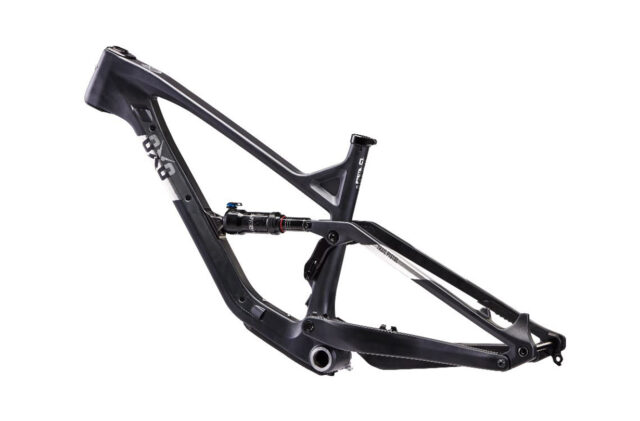
The new Trail Pistol’s front triangle is still the same thermoplastic carbon fiber piece that we’ve now tested as a Trail Pistol, a Smash, and a Gnarvana. It does get some sweet new graphics, but it’s otherwise unchanged. That means that it still features their reach-adjust headset, which gives 10 mm of reach adjustment on any given size, and clever semi-internal cable routing, with a bolt-on cover on the non-drive side of the downtube. Clearance for at least one water bottle, inside the front triangle, remains across the size range, and a second set of mounts accommodates a second, smaller, bottle on some sizes, or can be used to mount a spare tube, multi-tool, and the like. There are replaceable ISCG ‘05 tabs for a chainguide as well.
The big story with the new Trail Pistol is the rear triangle. Where prior Guerrilla Gravity frames have used aluminum rear ends, the Trail Pistol now gets a rear triangle made from GG’s Revved carbon. If you’re curious for more information on that, you should definitely check out Episode 3 of our Bikes and Big Ideas podcast, where we talk with the Guerrilla Gravity crew about the technology (while you’re at it, you should probably also listen to our fun conversation with Yoann Barelli, who recently signed with Guerrilla Gravity). But in short, Guerrilla Gravity is using thermoplastic carbon fiber (in contrast to the more typical thermoset carbon materials), which allows Guerrilla Gravity to substantially automate the layup process and offer a carbon frame that they claim to be up to 300% more impact resistant than its competition. The Revved approach also allows Guerrilla Gravity to recycle the material and use it to make new Revved components. That aspect is still fairly new, but is something they’re reportedly working on with the goal of making fully recycled, full Revved frames in the future.
Guerrilla Gravity says that the new Trail Pistol rear triangle shaves off 300 g compared to the prior version, and manages to be 50% stiffer despite the weight loss. It’s still a Horst link layout with 120 mm of rear travel, but there are some additional tweaks with the new generation bike.
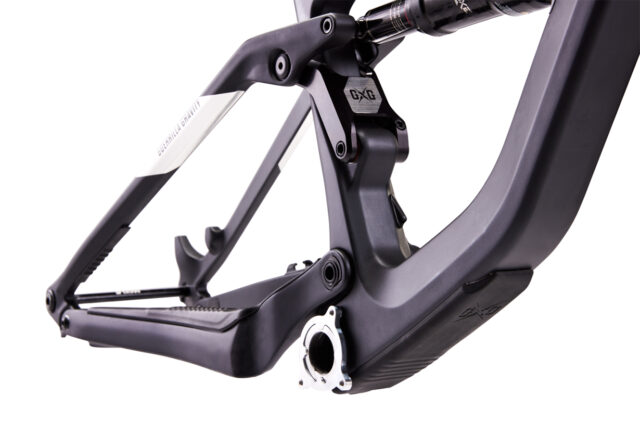
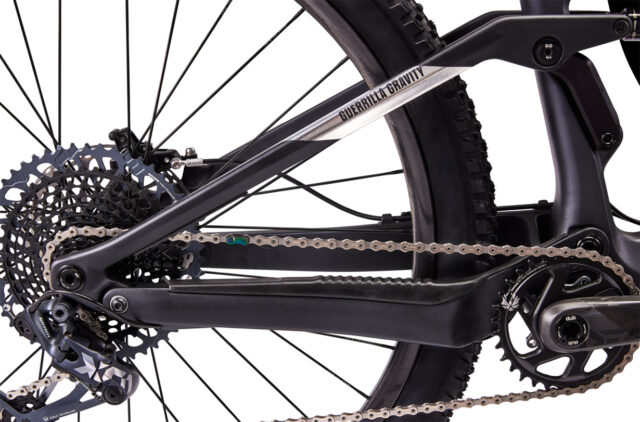
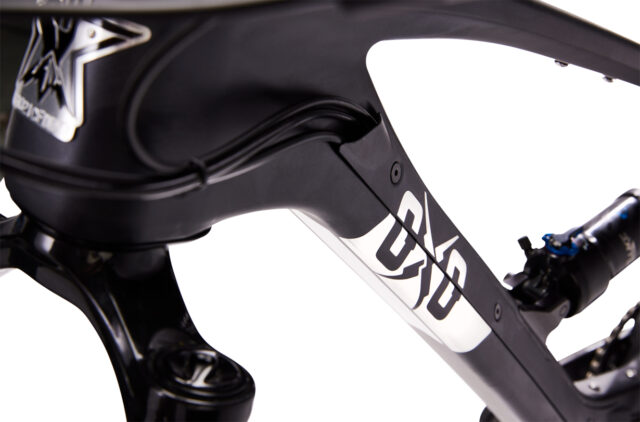

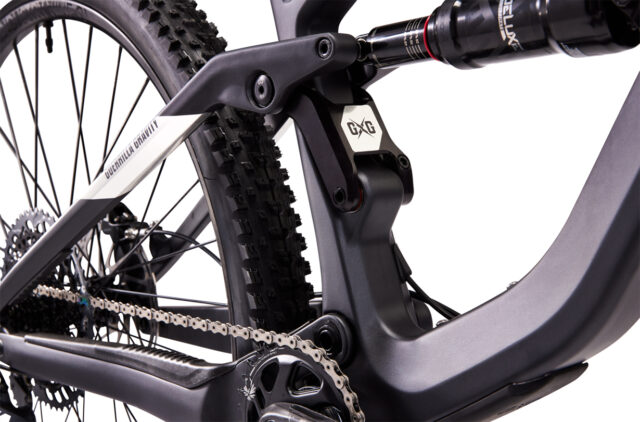


For one, the Trail Pistol now features post-mount brake mounts, for a 180 mm rotor, in place of the 160 mm IS mount on the outgoing model. There’s also a re-designed rubber guard for chainstay protection, and a new style of rear brake hose clips on the chainstay, which dispenses with the need for zip ties to secure the brake hose.
While the outgoing Trail Pistol used cartridge bearings for the dropout pivots, the new version goes to Igus bushings, which Guerrilla Gravity says are lighter, stiffer, and lower maintenance in that particular application. Gone also is the Plush Mode / Crush Mode flip chip, which toggled the rear suspension between two kinematic settings — Guerrilla Gravity says the new version is “permanently plush, with increased small-bump compliance.”
The 2021 Trail Pistol also gets a SRAM Universal Derailleur Hanger, which first showed up in the Guerrilla Gravity lineup on the Gnarvana, and the Trail Pistol also moves to a standard, zero-dish rear wheel. The outgoing Trail Pistol, and the rest of the GG lineup, have come spec’d with a rear wheel that’s offset 3 mm to the non-drive side. Guerrilla Gravity argued (I think correctly) that this led to a better chainline, but decided that the benefit wasn’t great enough to justify the hassle (also correctly, in my opinion) and ditched this particular feature.
The Builds
The new Trail Pistol is offered as a frame only, or in one of three stock builds. As per usual for Guerrilla Gravity, there’s also a great deal of customization available for those builds — you can go on their online build configurator and set up your bike to your particular specifications. Certain component selections are a bit limited at the moment due to Covid-related supply chain difficulties, but there are still a lot of options available, and the highlights of the stock builds are as follows:
Includes chainstay and seat stay assembly plus all required hardware to update another model that uses the Modular Frame Platform.
- Shock: RockShox Deluxe Select (many other options available)
- Fork: RockShox Pike Select RC
- Shock: RockShox Deluxe Select
- Drivetrain: SRAM NX Eagle
- Brakes: SRAM Guide T
- Wheels: Sun Ringle Duroc SD37 Comp
- Dropper Post: SDG Tellis
- Fork: RockShox Pike Ultimate RC2
- Shock: RockShox Deluxe Ultimate
- Drivetrain: SRAM GX Eagle
- Brakes: SRAM G2 RSC
- Wheels: Stan’s Arch MK3
- Dropper Post: SDG Tellis
- Fork: Fox 34 Factory Grip2
- Shock: Fox DPS Factory
- Drivetrain: SRAM X01 Eagle
- Brakes: SRAM G2 Ultimate
- Wheels: Industry Nine Trail 270
- Dropper Post: Bike Yoke Revive
All of these can be customized to your heart’s content, including swapping out different drivetrains from SRAM, Shimano and Box, as well as myriad options for suspension, brakes, wheels, and cockpit parts. And finally, the new Revved rear triangle is also available on its own for anyone who wants to convert any of Guerrilla Gravity’s other frame models (those with Revved carbon front triangle only).
Geometry
The geometry of the Trail Pistol has been slightly tweaked, but doesn’t stray too far from the prior generation. It’s still offered in three sizes (labeled Size 2, 3, & 4; effectively a Medium through Extra Large in most brands’ sizing schemes). The headtube angle has been relaxed a touch, to 65.4°, and the chainstays lengthened by 4 mm, to 430 mm (same across all sizes). The effective seat tube angle is still steep, at 77.9° to 78.3°, depending on size, and the reach ranges from 458 to 523 mm, based on size and headset position.
All of that is on the aggressive side of the median for a 120mm-travel trail bike, but isn’t totally off in left field by any stretch. Like we found with the last generation of Trail Pistol, we expect the new bike to be a particularly stable, capable bike for its travel class when it comes to descending at speed. Check out the full geometry chart below:
I like what Guerrilla Gravity has done here. The prior-generation Trail Pistol felt much more like an Enduro bike with less travel than it did a Cross Country bike with more aggressive geometry. As someone who tends to gravitate towards longer-travel, more gravity-oriented bikes, the outgoing Trail Pistol wrapped a lot of what I like about those sorts of bikes into a more efficient, poppier package. It wasn’t a bike that was going to appeal to the XC-race crowd, but was an absolute blast for the right sort of rider who still mostly wanted to charge on the descents, but also was looking for something more efficient than their typical ~160mm-travel Enduro sled on the way back up. The new Trail Pistol looks to lean into that niche, and cut a significant amount of weight while it’s at it.
The only thing I’d really like to see change is the introduction of a Size 1. Guerrilla Gravity had planned to make a smaller size when they initially launched the range of Revved bikes a few years ago, but shelved that size to keep up with demand for the larger options. Guerrilla Gravity’s size configurator recommends the Size 2 for riders as short as 5’4” / 163 cm (and to be fair, the geo adjust headset does stretch three frame sizes further than most bikes would manage to), but there are still plenty of shorter riders, especially women, who could benefit from a smaller option.
Some Questions / Things We’re Curious About
(1) Does the new Trail Pistol still feel like an especially aggressive bike in the ~120 mm travel class, or has its diet shaped it up into something wildly different? (We bet it still rages.)
(2) What sort of riders are going to be best served by the new Trail Pistol, and who should be looking for a longer-travel option, or a more XC-oriented ~120mm-travel bike?
(3) How different / how much stiffer does the new Revved rear triangle feel compared to the old aluminum version (which was not exactly flexy itself)?
Flash Review
Blister Members can read our Flash Review of the Trail Pistol for our initial on-trail impressions. Become a Blister member now to check out this and all of our Flash Reviews, plus get exclusive deals and discounts on gear, and personalized gear recommendations from us.
The Bottom Line (For Now)
The new Guerrilla Gravity Trail Pistol makes some very promising updates to what was already one of the more interesting bikes on the market, and we’re looking forward to getting on the latest version and seeing how it stacks up to the older model, and the rest of the class of short-travel, aggressive Trail bikes. We should be getting trail time on one soon, so stay tuned for our full review.
FULL REVIEW
I’d been pretty excited to review the updated Trail Pistol since it was announced last year. The prior version was a whole lot of fun, and an interesting take on a shorter-travel bike, in that it felt like just a little “more” bike than most 120-mm travel Trail bikes. And while I didn’t expect the new Trail Pistol to deviate too wildly from the prior generation (it uses the same front triangle, after all), the tweaks that Guerrilla Gravity made — chiefly, slightly longer chainstays and claimed better small-bump sensitivity — sounded like exactly what I would have aimed for if I were in charge of the update. I’ve now spent a lot of time on the new fully-Revved Trail Pistol, and my hunch was right — it’s not a wildly different bike than before, but the changes that Guerrilla Gravity made were absolutely for the better.

Frame Conversion & Details
Guerrilla Gravity sent over their Modular Frame kit for the new Trail Pistol, so that we could convert our longstanding test bike over. The same front triangle has now served as our review platform for two generations of the Trail Pistol, as well as the Smash and Gnarvana. When we first got on the new modular platform bikes a few years ago, we wondered if and when the Geo-Adjust headset (check out our review of the prior-generation Trail Pistol for a whole lot more on that) would creak or otherwise cause headaches, and I think we can now safely lay those worries to rest. It’s been completely trouble-free.
Converting to the new Trail Pistol from one of the other models is a bit more involved than swapping between versions that use an aluminum rear triangle, but it’s still pretty easy. You’ll need to remove the rear wheel, brake, and derailleur from the bike, then remove the seat stays and chainstay assembly. Installing the new rear triangle only takes a few Allen wrenches and about 20 minutes, but there are a couple of minor compatibility pitfalls to be aware of.
First, the new Trail Pistol uses 8 x 30 mm hardware for the rear shock mount, in place of an 8 x 35 mm version on the other models, so you’ll need to swap that out as well. And the new Trail Pistol forgoes the offset rear end that Guerrilla Gravity uses on the models with an aluminum rear triangle. If you’re using a rear wheel from one of those bikes, you’ll also need to re-dish it 3 mm back to the drive side in order for everything to line up.
Everything lined up nicely and went together smoothly in doing the conversion, though the semi-internal routing Guerrilla Gravity uses in the front triangle is a little bit of a hassle. In short, the cables sit in a groove in the non-drive side of the downtube and are secured with a bolt-on cover that hides them from view, but avoids the typical headaches of having to route them through the frame. As an avowed enemy of internal cable routing, I’m a big fan of this system in theory, but the actual implementation of it is a little more clunky. It’s not ideal that all three cables have to go down the same side of the frame, and keeping them routed neatly and secured in the groove while you bolt the cover back on is a bit tricky with just two hands to work with. A minor annoyance to be sure, but there’s some room for refinement there.

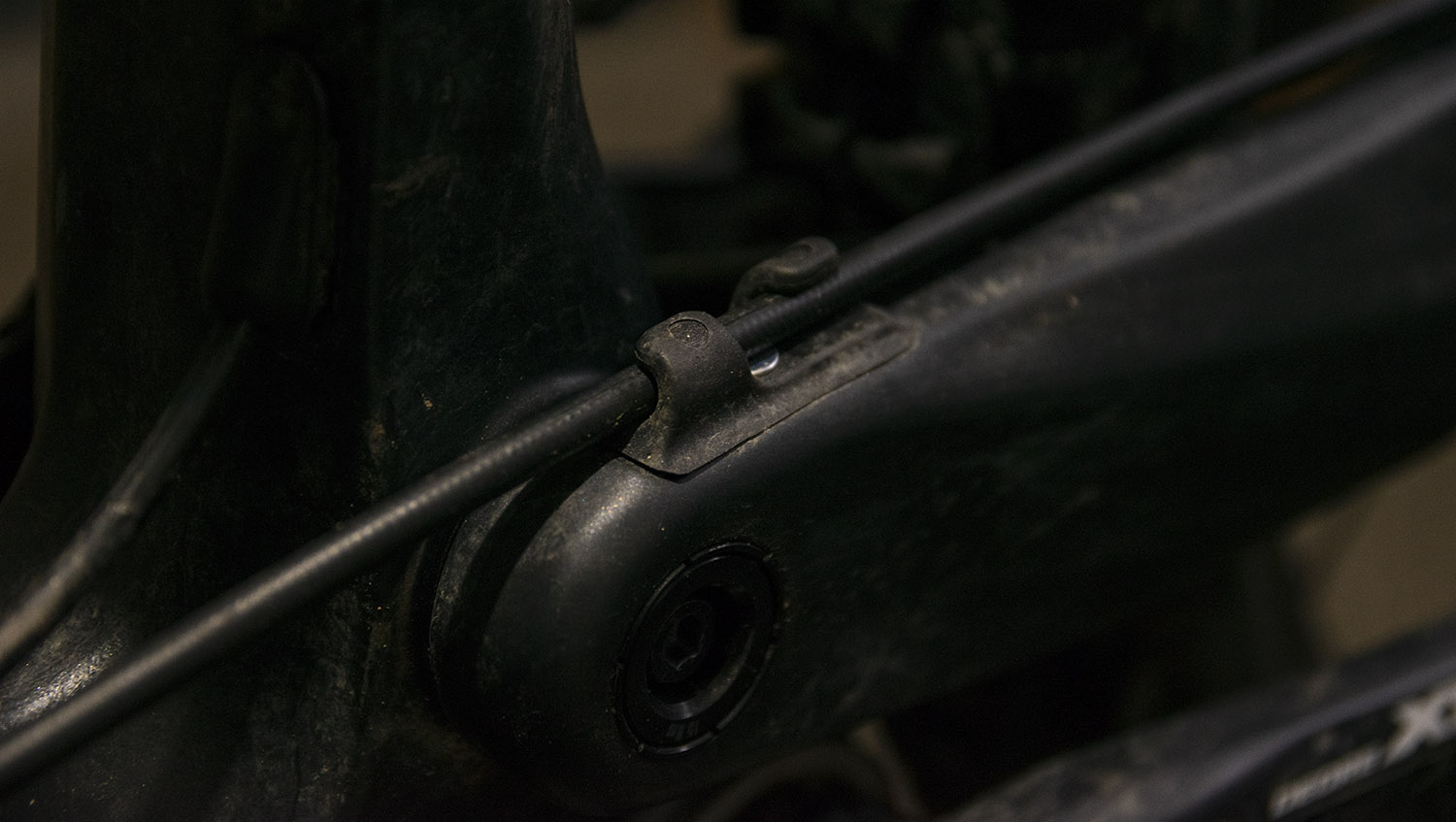
Swapping to the Revved rear triangle saved 160 g compared to the older aluminum Trail Pistol rear end, and while that’s not a whole lot of weight savings, I was more excited about the geometry and suspension tweaks, anyway. So with the swap complete, it was time to get the new Trail Pistol on dirt.
Fit & Sizing
No big surprises here — the new Trail Pistol fits a whole lot like the old one. It’s the same front triangle, after all, with only subtle tweaks made to the geometry via the new rear triangle. To be clear, the other models based on the same platform do have some notable differences in fit and cockpit layout — as you go up in travel and the fork gets longer and the headtube gets slacker, the stack increases and the reach comes down a bit, since the front triangle is essentially rotating rearwards. At 6’ / 183 cm tall, Guerrilla Gravity’s sizing calculator puts me on a Size 3 frame whether I select “All Around” or “Full Throttle” for riding style, and I think that’s definitely the right call. I wasn’t ever tempted to deviate from the Size 3 frame (with the headset in the longer position) and was very happy with the fit there.
At 78.1° effective (74.3° actual), the seat tube angle on the Trail Pistol is pretty steep, but not so over the top that it feels awkward in flatter, more rolling terrain. It is worth noting, though, that I spent most of my time on the Trail Pistol with a 140mm-travel fork on it, rather than the 130 mm one that Guerrilla Gravity specs as stock (more on that later), which should have slackened the seat tube by about 0.5°.
Guerrilla Gravity’s Geo-Adjust headset is a really nice touch and one that makes fine-tuning the fit of the bike a lot more viable than it is on most other bikes. As Noah Bodman noted in our review of the prior-generation Trail Pistol, running the headset in the shorter position does have some very minor downsides — notably that it looks a little funky and might prevent you from running the stem fully slammed, due to clearance issues (depending on the stem in question) — but those are pretty minor details in our book. And even though I personally didn’t have any need to move the headset from the long position, having been on a few bikes recently where I felt somewhat between sizes, the smaller reach increments that it affords are very welcome.
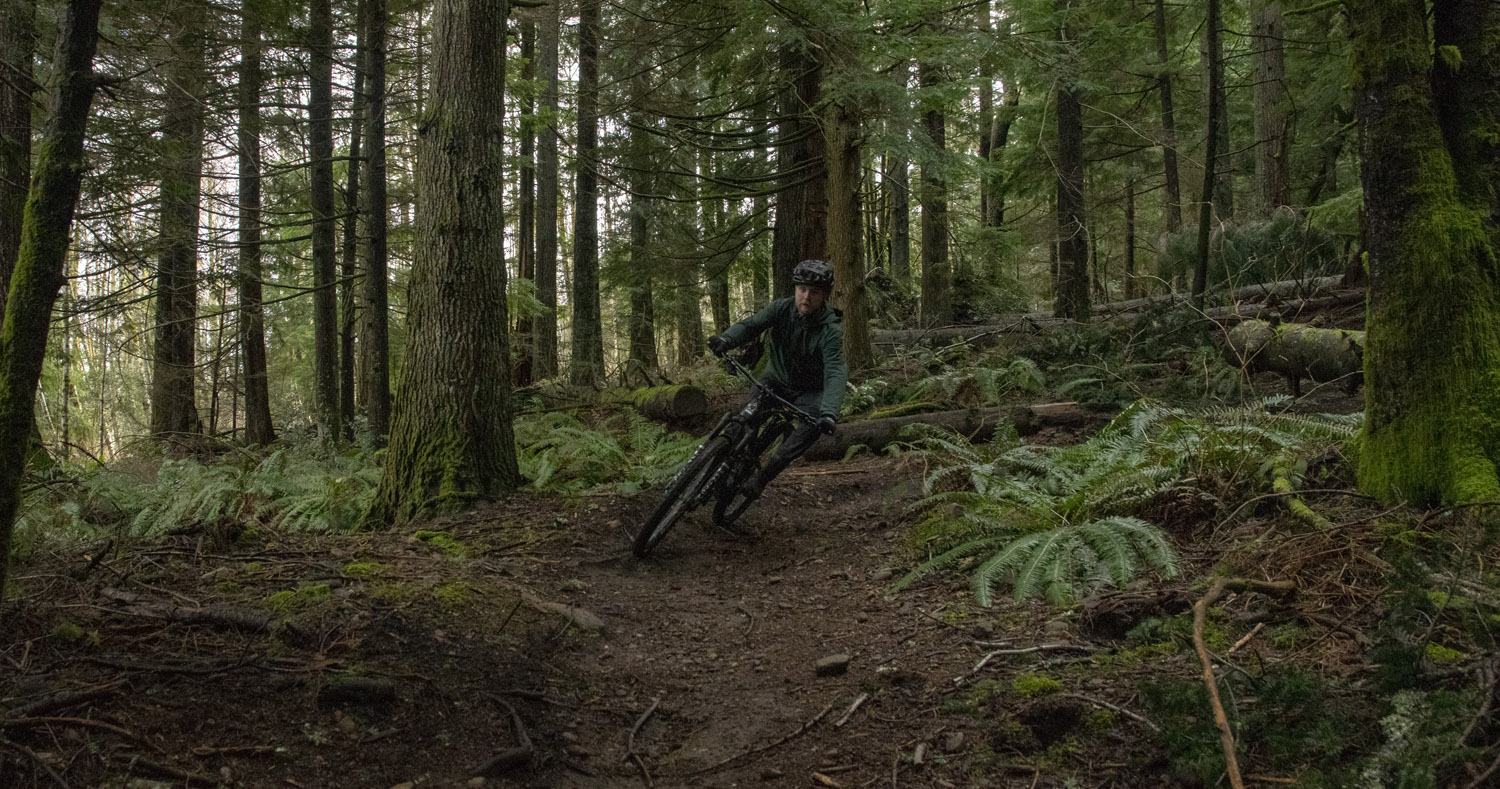
Climbing
Like the prior-generation bike, the new fully Revved Trail Pistol climbs quite well overall but isn’t especially sprightly for a 120mm-travel bike. That qualifier is important — it’s still more efficient than most bikes with substantially more rear suspension travel. But folks whose top priority is to find a super snappy, ultra-efficient bike are probably better off looking elsewhere.
Put differently, some 120mm-travel Trail bikes feel a lot like an XC race bike that’s been stretched longer and slacker, and given a little extra suspension; others feel more akin to an Enduro bike that’s been made sharper handling and given less suspension. The Trail Pistol is definitely in the latter camp, and considering that it shares a front triangle with Guerrilla Gravity’s actual Enduro bike, the Gnarvana, that makes some sense.
But if you’re not expecting the Trail Pistol to remind you of an XC race bike, it climbs plenty well. The pedaling position is great, and despite the fairly short chainstays, the Trail Pistol doesn’t take much effort to keep the front wheel planted but also doesn’t feel so long and ponderous as to be a chore in tighter, more technical bits of climbing. The Trail Pistol feels quite efficient if you’re not trying to really attack and set every climbing KOM in sight. It’s a great bike for super long days where you still want to do some fun descending but just doesn’t feel quite as snappy as a lot of other 120 mm bikes (including the Transition Spur and Pivot Trail 429) if you really get on the pedals and try to sprint.
Given what I’m about to say about the Trail Pistol on the way back down, I’m totally fine with that — and again, it’s still a better climber than most bikes with significantly more travel. Just think of the Trail Pistol as being a little bit more descending-oriented than most 120mm-travel Trail bikes, and if that sounds appealing to you, it’s a really good option.

Descending
The Trail Pistol is an exceptionally fun bike on the way back down, especially for intermediate to advanced riders who are willing and able to push the bike a little bit and ride with relatively good technique. It’s not a super easy-going bike that will be a top choice for riders who want a bike that feels especially cushy and forgiving under mellower riding, but, crucially, it also doesn’t take a whole lot of speed or burly terrain to come alive. Kind of the opposite, in fact. It’s not a bike that’s going to iron out every little trail feature but for folks who are willing to trade that off for a more lively ride, it’s a great combination of being fairly capable — if ridden with decent technique — while still working great on more mellow trails, too.
That’s not to say that you need to be a great rider to get along with the Trail Pistol by any stretch. But I do think that it’s important to situate the Trail Pistol relative to both more XC-derived ~120mm-travel bikes, and longer-travel Trail ones. And my hunch is that many less aggressive riders will find themselves preferring a bike in one of those other camps, depending on where and how they plan to ride it. To reiterate, the Trail Pistol feels more descending-oriented than a lot of bikes with similar travel (e.g. the Transition Spur, Ibis Ripley, etc.) and it wouldn’t be my first choice for riders looking for a bike that’s ultra-efficient first and foremost. But while the Trail Pistol is quite capable for a 120mm-travel bike, it is still a 120mm-travel bike, and as such isn’t as cushy or forgiving of mistakes when going hard as most Trail bikes in the ~140-150 mm travel range. And so riders looking for an all-rounder do-it-all bike that makes pushing harder and riding faster easier, a bit more suspension would likely help.
But if you’re a rider who wants a bike that combines a more lively ride with enough stability to push harder and go faster than those more XC-oriented 120mm bikes, the Trail Pistol makes a very strong case for itself. And I think there are a lot of riders who spend a lot of time on Enduro and/or DH bikes who would really enjoy the Trail Pistol as a shorter-travel complement to their big bikes. It’s certainly not a replacement for a long-travel Enduro bike but does feel a bit more like one that’s been made a little lighter duty and shorter travel than most other bikes with similar travel, and that’s a compelling option for more gravity-oriented riders looking for a bike that makes mellower terrain and longer days in the saddle more fun than their big bikes.

We noted that the small bump sensitivity of the prior-generation Trail Pistol left a bit to be desired. Guerrilla Gravity apparently agreed and tweaked the kinematics of the new Trail Pistol with the goal of upping the sensitivity a bit. And it worked — the small bump sensitivity of the new Trail Pistol is indeed better. Switching the Fox DPX2 Performance Elite shock that I tested on the old Trail Pistol for a Fox Float X Factory (review coming soon) helped even more, but even with the DPX2 installed, the new Trail Pistol is a marked improvement over the old one. It’s a little tricky to tease out to what extent that’s down to changes in suspension kinematics vs. different ride quality from the carbon rear end, but whatever the case, the new Trail Pistol is a bit cushier than the old one.
Of course, it’s still a 120mm-travel bike, and I don’t want to give the idea that the Trail Pistol has turned into some ultra-cushy, plush ride. It’s a short travel Trail bike that favors a fairly firm suspension setup overall, but Guerrilla Gravity has done a really nice job of making the new bike a little more sensitive off the top, without making the bike wallowy or unsupportive deeper in the travel.
Guerrilla Gravity also lengthened the chainstays slightly, to 430 mm (from 426 mm on the older bike) and I’m a fan of that move, too. That extra 4 mm isn’t a huge change, but 426 mm is really short for a 29er, and at 430 mm the updated Trail Pistol feels just a touch more balanced and stable without losing much nimbleness. The last-generation bike required a bit more care to stay forward on the bike and keep the front wheel weighted, whereas the new Trail Pistol can be ridden more neutrally without feeling like all your weight is on the back wheel. Again, it’s not a night-and-day difference by any stretch, but a nice subtle tweak for the better, in my opinion.

The Build
Though a whole lot of the parts I used to build up the Trail Pistol aren’t things that Guerrilla Gravity offers on their stock builds, I’ve still got some thoughts that I think will be helpful for folks building out their own Trail Pistols, particularly given how much flexibility Guerrilla Gravity offers in their build specs.
As I hope I’ve made clear by now, the Trail Pistol isn’t the most sprightly-feeling 120mm-travel bike out there, but it’s also a good bit more capable and forgiving feeling than a lot of (generally shorter, steeper) 120mm-travel bikes, and so I think it’s a strong candidate for building up with a slightly more stout build than the average short travel Trail bike. I started with a 130 mm RockShox Pike Select up front, but found myself wanting the front end a little higher — and a better performing damper — so I pretty quickly swapped in a Manitou Mezzer Pro, set to 140 mm.
That did the trick. The Mezzer is probably overkill for the Trail Pistol, but it’s an extremely good fork and quite light for how stiff it is, so it didn’t feel out of place at 140 mm travel (the shortest configuration that Manitou officially supports for it). You can read my full review for more, but it’s also exceptionally supportive, which makes it a good match for a relatively lively, short-travel bike such as the Trail Pistol.
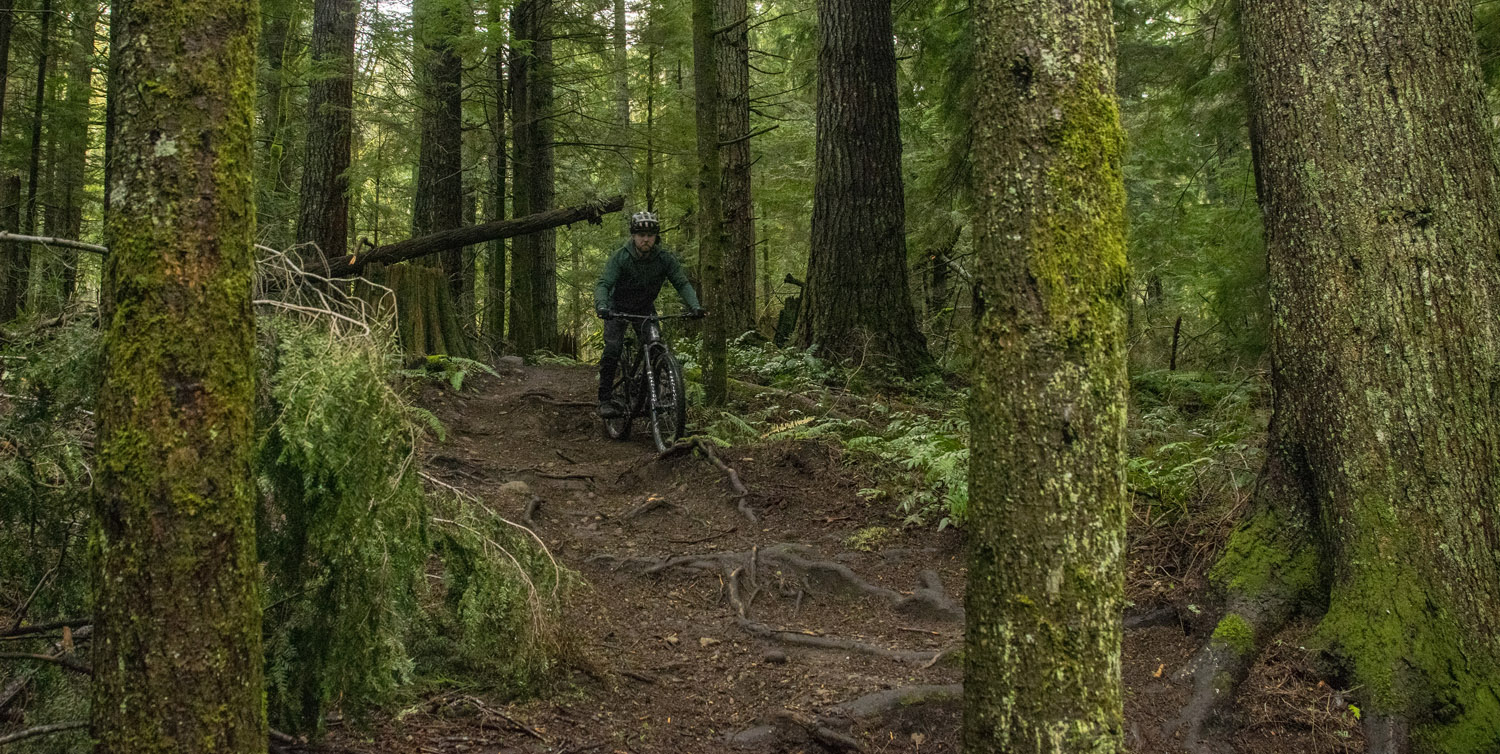
Guerrilla Gravity also offers a longer-travel “secret menu” version of the Trail Pistol, dubbed the Pistola. The Pistola gets an extra 10 mm of rear travel (up to 130 mm) via a longer stroke shock, and pairs that with a 150 mm fork, which raises the bottom bracket by a stated 9 mm and slackens the headtube and seat tube by about 0.8°. I briefly experimented with a Pistola configuration on the Trail Pistol by removing the travel limiting spacer from the Float X rear shock (bumping the stroke to 55 mm, from 50 mm) and converting the Mezzer to 150 mm, but didn’t love the higher bottom bracket and taller front end that resulted. And so I eventually settled on splitting the difference, running the Trail Pistol with the Mezzer at 140 mm travel, and toggled back and forth between the 120 and 130 mm rear travel settings a few times to compare.
Building your Trail Pistol as a Pistola gets you some options for more heavy-duty rear shocks (e.g. the Fox Float X that I tested the bike with), bigger brakes, burlier forks, and so on. And since changing travel in most modern air-sprung forks is a fairly quick and easy job that requires, at most, a different air shaft, starting with a Pistola just might be a viable option even if you don’t want to run the bike with a 150 mm fork.
The resulting geometry changes from experimenting with fork length made a much bigger difference in how the Trail Pistol / Pistola rides than the 10 mm rear wheel travel change that you get by changing the rear shock stroke (since the eye to eye doesn’t change, neither does the static geometry). Predictably, the 130 mm mode feels a touch softer and more compliant, and a little less lively, but it’s not a big difference, at least when using the same shock in both settings. And so I’d focus a lot more on the parts spec than the travel numbers, and choose which version to start your build from based on what parts you want to put on it.
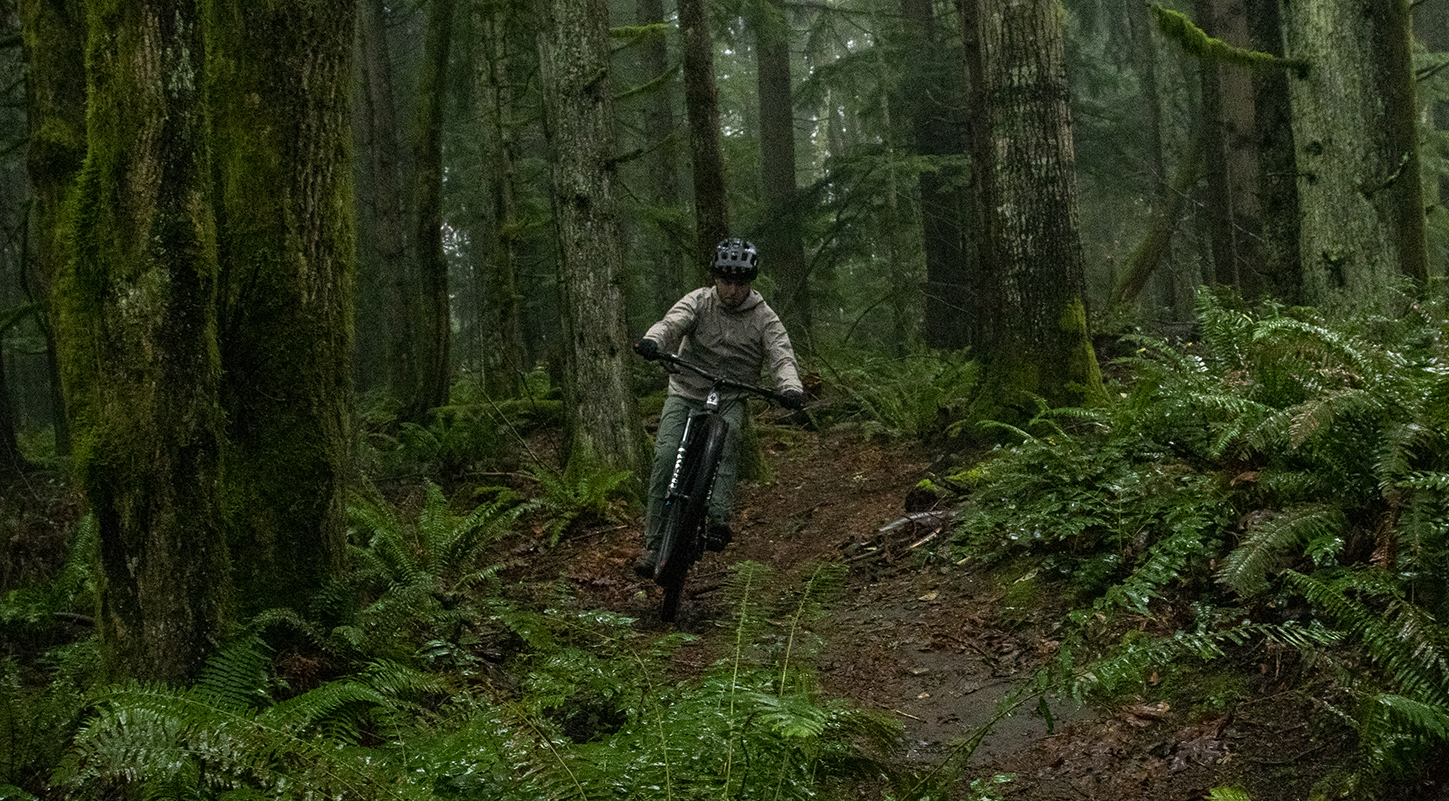
Comparisons
The Yeti SB130 and Trail Pistol are fairly similar in some respects and substantially different in others. They remind me quite a bit of each other in terms of their fit and handling characteristics, but the suspension on the SB130 feels firmer and more lively, whereas the Trail Pistol is a bit more plush and planted. The SB130 is also a little more efficient under power but gives up a bit of traction when the climbing gets looser and more technical.
Ibis Ripley
I’ve spent a little bit of time on the Ripley — and we put out a full review of the Ripley AF last year — and in short, the Ripley is considerably snappier under power and more efficient than the Trail Pistol, but also less stable, composed, and capable when speeds pick up on the way back down. When I talked about some ~120mm travel bikes feeling more XC-derived, the Ripley was one of the first bikes that came to mind. The decision between the Ripley / Ripley AF and the Trail Pistol should be a pretty easy one, depending on whether you want a bike that emphasizes climbing and covering lots of ground quickly (Ibis) or one that gives up a bit of that efficiency in exchange for being a substantially more game-on, capable descender (Guerrilla Gravity).
The Spur feels like it splits the difference between the Ripley and the Trail Pistol on the efficiency vs. downhill capability spectrum. The Trail Pistol is definitely more bike, overall — though going very light on the build spec would narrow that gap somewhat — and is more stable and forgiving in more technical terrain, but heavier and not as snappy when you really step on the pedals. The Trail Pistol frame also feels significantly stiffer and more stout than the Spur, at the expense of some extra weight.
This might seem like an odd comparison — the Occam LT has much more suspension travel than the Trail Pistol, with 150 mm at both ends — but they’re an interesting contrast in different approaches to making a versatile Trail bike. The Occam LT pedals exceedingly well for a 150mm-travel bike, and is actually surprisingly close to the Trail Pistol on that front. And with its added suspension travel, it does feel a bit cushier and move forgiving, too.
But despite all that, the Trail Pistol actually feels more stable at speed, and like a better fit for more aggressive riders who want a relatively efficient Trail bike that still largely emphasizes downhill performance. And the Occam LT will likely work better for folks who want a bike with more suspension that’s also quite quick-handling and nimble and are okay giving up a bit of stability at higher speeds as a tradeoff.
Unfortunately, we don’t have any reviewers who have spent time on both bikes to directly compare, but from chatting with Eric, Dylan, and Luke about their impressions of the Phantom, I can make some educated guesses.
My hunch is that the biggest point of differentiation is going to be the type of body positioning that they encourage — the Phantom has much longer chainstays and a bit shorter reach than the Trail Pistol, and our reviewers who spent time on it all felt like it worked best being ridden fairly centered, whereas the Trail Pistol does encourage a more aggressive, forward stance. But in other respects, they do sound pretty similar — they’re both short-travel Trail bikes with a relative focus on descending prowess over maximum efficiency.
Once again, we’ve had different reviewers spending time on the Trail Pistol and Trail 429, but I’ll do my best to triangulate the comparison based on our other folks’ impressions of the Pivot.
In short, the Trail 429 sounds like a snappier, more lively, and efficient take on a short-travel Trail bike, but one that still punches a bit above its travel class in terms of downhill capability — especially with the Enduro build spec that we tested. I’d expect it to be a little more efficient than the Trail Pistol, but a little less planted and stable feeling.
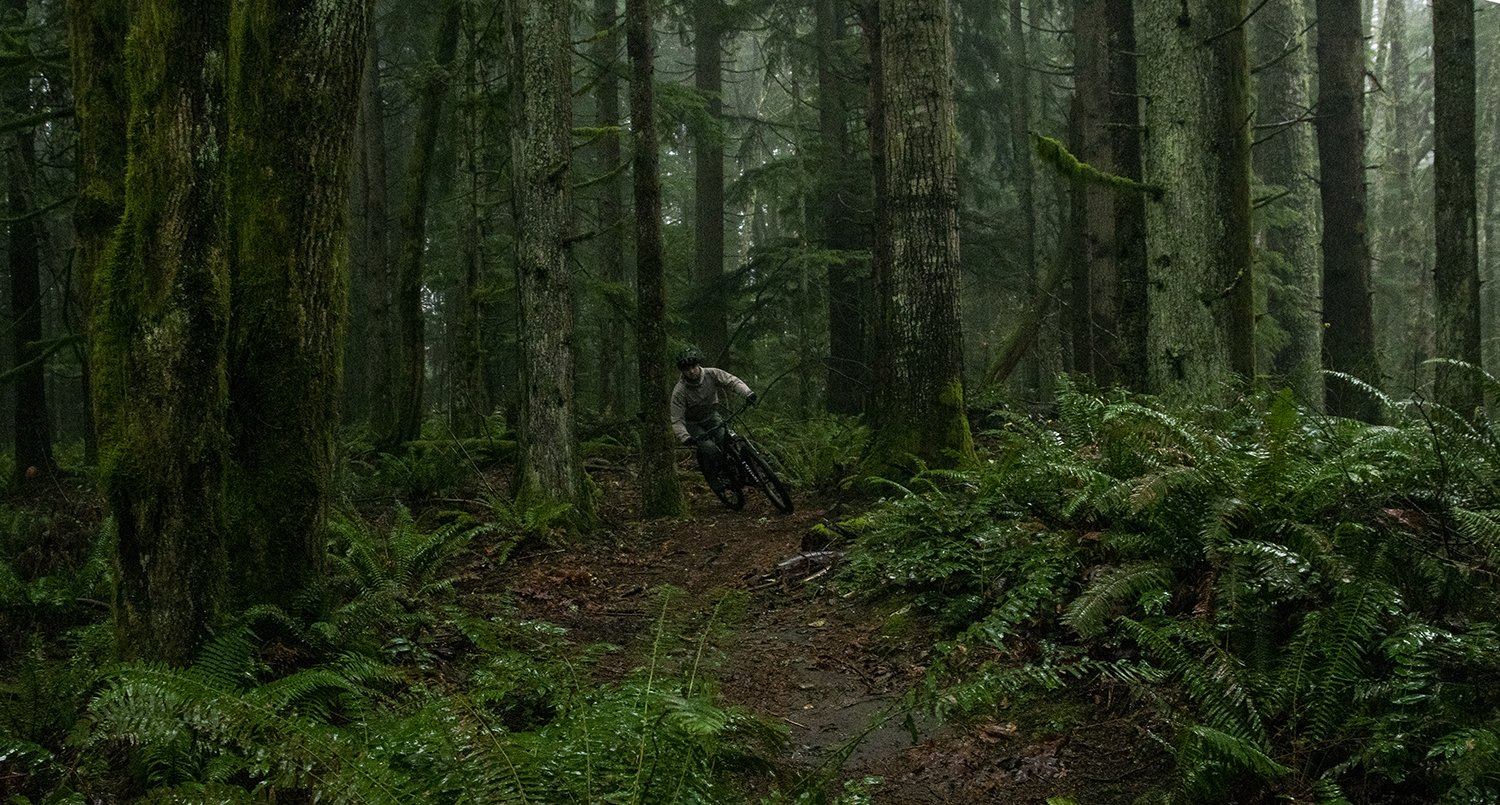
Who’s It For?
I think the Trail Pistol makes the most sense for intermediate to advanced riders with a bit of a gravity focus, who either want a shorter-travel, more efficient alternative to their bigger Enduro bikes that will come alive at lower speeds, or as a one-bike quiver for those sorts of folks who live somewhere without the terrain to put a bigger Enduro bike to use.
I want to be careful not to make the Trail Pistol sound more demanding than it is — it’s not like it’s a bike that you need to be super aggressive and skilled to have a great time on. It’s just that it does feel a bit more gravity-focused than a lot of other 120mm-travel bikes (e.g. the Ibis Ripley) and so it makes the most sense for riders who share that mindset, and don’t need the extra suspension of a longer travel bike to bail them out once the speeds pick up a bit.
Bottom Line
I was a big fan of the prior-generation Trail Pistol, as a short-travel Trail bike that’s focused more on making descending fun over maximum efficiency and speed on the way back up. And while the latest Trail Pistol feels more like a modest update than a wholesale overhaul of the bike, the changes that Guerrilla Gravity made were for the better. And since they were starting from an already-good place, that’s plenty.
The Trail Pistol is an excellent choice for a short-travel complement to a bigger Enduro bike for the sorts of riders who spend a lot of time on those, or for riders who are more interested in descending than climbing quickly but ride a lot of terrain that doesn’t justify a full-on Enduro sled. And the added versatility of Guerrilla Gravity’s modular frame platform, their highly customizable build kits, and the fact that the frames are made in Colorado are all great bonuses, too.


Hey David, you have done some testing on a couple of GG’s bikes. Can you say anything on the revved carbon in regards to our normal carbon? Does it hold up better? Have you tried to recycle it already?
Yo David, you can borrow mine for a spin if you want. Just got it and pretty happy about how it’s been so far. Inaugural lap was on a certain South African sandwich out at 27. Definitely different than on my warden, but handled it fine.
Appreciate the offer! Actually just (finally) got one in a couple days ago. Flash Review coming very soon, and a full one in a bit.
Just to say, I think every bike should have a reach adjust headset.
Frame sizes jump about 20-30mm in reach with each size.
In the past, you fine tuned with stem length. 90 or 105 mm stem doesn’t make a huge difference in handling.
But these days, changing from 30 > 55 mm gives a huge difference in handling.
Reach adjust headsets allow for the ‘1/2 size’ options that allow for good fit, while still being able to keep stem length in a very narrow range for proper handling.
thanks for covering the nitty gritty details on the new rear triangle! I was thinking about picking up a revved rear, but it sound like it will make switching between the builds harder
I’m having a blast with my full Revved Pistola. Size2
I set my up with a 130mm rear MegNeg installed first week(1 token 1 spacer)and 140mm 51mm offset Pike. The extra travel and longer offset give a bit slacker head angle and a longer wheelbase. Stock spec wheelbase is 1200mm mine is at 1218mm.
Quite the change for me I’ve been on full coil bikes for 7 years. I loving the more playful poppy bike and I’ve actually got PRs on the more recent trails.
Thanks for the review. It was good to see another’s opinion.
Cheers
David, can you compare the Trail Pistol to the Santa Cruz Tallboy 4? Thx.